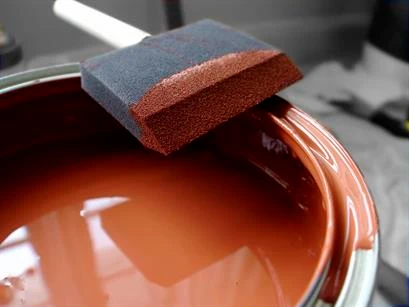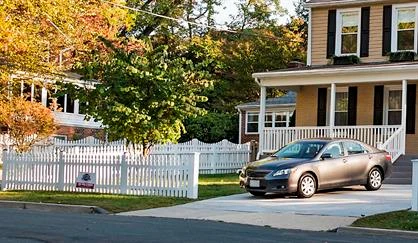Paint or Stain My Fence?

Should I Paint or Stain My Fence?
Whether you have a new fence that's ready for a topcoat or your old fence is in need of attention, deciding whether to paint or stain is a common stumbling block for homeowners. Each has their pros and cons, and we're here to go down the list to make sure you end up with a finish that's just right for your fence.
Generally, we recommend using stain on new fences since it lasts longer, penetrates the wood, and is easier to maintain.
Which Finish Lasts Longer?
If you're thinking of tackling a major project like painting or staining your fence, the first thing that comes to mind is how often you'll need to do this task. Both types of finishes need regular attention.
Stain should be reapplied at least every three years and paint every five to six years. The conditions that your fence withstands, such as harsh winters or considerable rainfall, may mean more frequent maintenance.
Stain tends to show its wear a little more pleasantly than paint. You may notice some areas of fading or deteriorating finish. Paint, on the other hand, tends to crack, bubble, and peel as the time to reapply draws near.
These are general guidelines: If your fence looks like it needs a fresh coat of paint or stain, apply it! It never hurts to do preventative maintenance too early. If you have a fence in your yard that has never been painted or stained, it’s never too late! Just take extra time to clean the wood well before treating it! If you want to remove the grey-color on weathered wood, use a commercial wood brightener before treating the wood.
Is It Cheaper to Paint or Stain a Fence?
We don’t recommend letting costs guide your selection. Paint is less expensive, but you’ll need more of it and you’ll also need primer. Stain is more expensive, but you won’t need as much of it and it can last longer than paint. In the end, both products cost about the same when you consider how much you need and how long they last.
 Which Finish Is Easier to Apply?
Which Finish Is Easier to Apply?
Stain wins here. Most stains can easily be applied with a handheld garden pump sprayer. Paint can also be sprayed on a fence, but it requires special equipment.
Stain wins here. Most stains can easily be applied with a handheld garden pump sprayer. Paint can also be sprayed on a fence, but it requires special equipment.
Stain can be a bit more forgiving during application as your fence will soak it up rather than sitting on the surface. This means it won’t show drips or runs as easily as paint. On the other hand, raw, rough wood is happy to have a coat of stain where the paint will require sanding and smoothing of the surface. No matter which finishes you choose, be sure to make any necessary repairs to your fence before you get started.
When it comes to reapplying, a painted fence requires more prep work. The fence will need to be lightly sanded and all peeling or flaking paint will need to be removed. Since stain cannot peel or flake, all it takes is a good washing to prepare the fence for a new coat of stain.
ProTip: Pressure washing can be a great way to get a clean slate before treating your old fence.
Lastly, paint can be applied in a wide variety of conditions as long as it's not raining. To apply stain, you'll have to wait until it's at least 50 degrees Fahrenheit or 10 degrees Celsius out, with no rain forecasted for at least two to three days.
 Customizing With Color
Customizing With Color
If you want a truly unique look for your fence, paint is the way to go, as your color selection is virtually endless. Stain manufacturers have created a variety of hues, and solid stain options give you color stain options that look like paint. However, if you're hoping for a fabulous fuchsia fence, paint is the only way to go.
Consider Your Surface
Lastly, before you make your decision between painting or staining your fence, consider the type of wood your fence is built from and what its current finish is.
- Cedar wood does not take paint well, and paint can actually reduce the lifespan of your cedar fence.
- Pressure-treated lumber can be painted or stained, but stain will not soak in as deeply with treated wood than it would with raw. It must dry out before treating, too.
- Rough sawn wood will need significant prep work if using paint. For this type of wood, we recommend an oil-based stain or an oil-based wood treatment such as linseed oil to preserve the raw look of the wood.
What happens if you don’t like the color of a fence around a home you bought and you want to stain over painted wood? We’ve covered all those details in a separate blog! It’s possible as long as you follow the tips from our experts in the link above.
Professional Fence Staining and Painting Services
If you're still not sure whether paint or stain is right for your fence, contact the pros at Five Star Painting. We'll look at the type of wood you have, its current condition, and add your color considerations to help you make the right decision. Give us a call today at (888) 261-3633 or request a free estimate online.
 Click to call
Click to call




